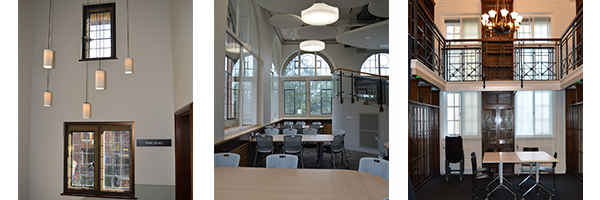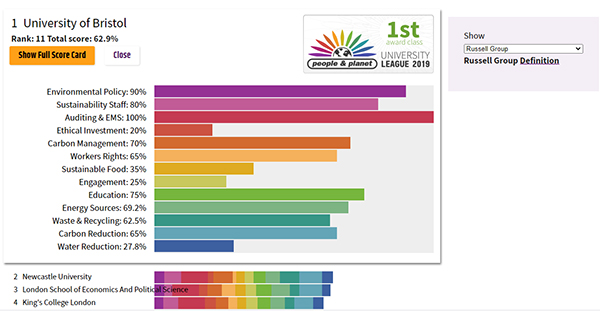Sustainability has become much more of a public talking point and at the forefront of many young people’s minds who wish to protect the world they live in. They are looking to educational institutions to aid them in recognising how and why daily choices can have a long-lasting impact on the environment, as well as proving what they are doing as an institution to be more accountable and sustainable.
International students, who represent an important cohort for universities, place great importance on green ethics and credentials. The results of a survey carried out with 250 international students by Western Union Business Solutions, was unveiled at the Times Higher Educations’s World Academic Summit in Zurich. It presented that 58% of those surveyed would reject a university if it had poor sustainability credentials.
It appears that green credentials may now be more of a commercial necessity than a luxury, particularly when it comes to appealing to students, whose commitment to environmental issues is illustrated by their mass participation in climate strikes, the world over. So why are more institutions not yet embracing a more sustainable stance?
Barriers preventing universities from doing more include financial pressures and lack of guidance/regulation from government and sector bodies. Another obstacle can be Senior leadership, who do not see climate change as a priority – its these perceptions and mindsets which need to adapt. However, with the transparency of universities’ ethical behaviour, they can no longer evade their climate change accountabilities.
Further and Higher education institutions occupy a unique societal position – they are powerful influencers of the next generation. International efforts must be embraced, such as the UN’s 2030 Agenda for Sustainable Development. Joy Carter, vice-chancellor of the University of Winchester stated last year that higher education institutions are “sleepwalking into a major environmental disaster, with the future of humanity at stake”.
Gradually more Universities are setting an example in order to influence the behaviour and awareness of local communities on carbon emissions and the part they play in helping ‘save the planet’. However, there is much more that can be done to get their own house in order. Aside from educating our future generations on the climate emergency and sustainable development, these institutions must lead by example and address their levels of carbon emissions.
Universities need to improve the environmental controls across their estates, which poses a challenge with campuses often being a mix of new and heritage buildings; but there is plenty which can be done. Investments can be made in renewables, energy saving technology and sustainable retrofit products can be implemented to reduce carbon consumption and ensuing emissions. For example, in a typical campus building, approximately 10% of heat loss is through the windows and a further 15% of heat loss is due to draughts if the building is old and has ineffective primary glazing – both of which can have a huge impact on energy bills too.
 Selectaglaze thermal low-E secondary glazing in a Cambridge University, Birmingham University and Imperial College London
Green building solutions such as secondary glazing with low-E glass can help these deficiencies simply and effectively, to significantly improve a building’s energy efficiency. Furthermore, secondary glazing offers a very important option for educational establishments as it is particularly suited to traditional buildings, those in conservation areas or Listed buildings with preserved facades. Well-designed secondary glazing can nearly halve heat loss through the glass and since it seals the whole window, draughts are markedly reduced. Our buildings account for more than 40% of all carbon emissions so any method of reducing this through controlled measures or improved insulation such as secondary glazing is very desirable to the environment.
Despite all this, there are many institutions which are taking this very seriously. One that has taken up the ‘green’ baton is the University of Gloucestershire, who came top of the People & Planet University League, which ranks the environmental and ethical performance of UK universities. Last year, it affirmed total fossil fuel divestment, and its Director of Sustainability, Alex Ryan, says the “educational mission is right at the heart of its sustainability strategy”.
Selectaglaze thermal low-E secondary glazing in a Cambridge University, Birmingham University and Imperial College London
Green building solutions such as secondary glazing with low-E glass can help these deficiencies simply and effectively, to significantly improve a building’s energy efficiency. Furthermore, secondary glazing offers a very important option for educational establishments as it is particularly suited to traditional buildings, those in conservation areas or Listed buildings with preserved facades. Well-designed secondary glazing can nearly halve heat loss through the glass and since it seals the whole window, draughts are markedly reduced. Our buildings account for more than 40% of all carbon emissions so any method of reducing this through controlled measures or improved insulation such as secondary glazing is very desirable to the environment.
Despite all this, there are many institutions which are taking this very seriously. One that has taken up the ‘green’ baton is the University of Gloucestershire, who came top of the People & Planet University League, which ranks the environmental and ethical performance of UK universities. Last year, it affirmed total fossil fuel divestment, and its Director of Sustainability, Alex Ryan, says the “educational mission is right at the heart of its sustainability strategy”.
 Bristol University was ranked #1 in the Russell Group by The People and Planet University League in 2019
Likewise, Keele University declared a climate emergency in May 2019 and has set a target to become carbon neutral by 2030. Mark Ormerod, the deputy vice-chancellor, says “the institution tries to embed sustainability in absolutely everything we do, from research to teaching to catering”.
What is clear, is that universities will only take giant footsteps towards becoming sustainable if it is a strategic priority. If embraced, sustainability benefits all involved – students, communities, staff, and society. Higher education has an ethical obligation to influence global efforts to make a sustainable future both in education and on a much-wider scale too.
Bristol University was ranked #1 in the Russell Group by The People and Planet University League in 2019
Likewise, Keele University declared a climate emergency in May 2019 and has set a target to become carbon neutral by 2030. Mark Ormerod, the deputy vice-chancellor, says “the institution tries to embed sustainability in absolutely everything we do, from research to teaching to catering”.
What is clear, is that universities will only take giant footsteps towards becoming sustainable if it is a strategic priority. If embraced, sustainability benefits all involved – students, communities, staff, and society. Higher education has an ethical obligation to influence global efforts to make a sustainable future both in education and on a much-wider scale too.
 Selectaglaze thermal low-E secondary glazing in a Cambridge University, Birmingham University and Imperial College London
Green building solutions such as secondary glazing with low-E glass can help these deficiencies simply and effectively, to significantly improve a building’s energy efficiency. Furthermore, secondary glazing offers a very important option for educational establishments as it is particularly suited to traditional buildings, those in conservation areas or Listed buildings with preserved facades. Well-designed secondary glazing can nearly halve heat loss through the glass and since it seals the whole window, draughts are markedly reduced. Our buildings account for more than 40% of all carbon emissions so any method of reducing this through controlled measures or improved insulation such as secondary glazing is very desirable to the environment.
Despite all this, there are many institutions which are taking this very seriously. One that has taken up the ‘green’ baton is the University of Gloucestershire, who came top of the People & Planet University League, which ranks the environmental and ethical performance of UK universities. Last year, it affirmed total fossil fuel divestment, and its Director of Sustainability, Alex Ryan, says the “educational mission is right at the heart of its sustainability strategy”.
Selectaglaze thermal low-E secondary glazing in a Cambridge University, Birmingham University and Imperial College London
Green building solutions such as secondary glazing with low-E glass can help these deficiencies simply and effectively, to significantly improve a building’s energy efficiency. Furthermore, secondary glazing offers a very important option for educational establishments as it is particularly suited to traditional buildings, those in conservation areas or Listed buildings with preserved facades. Well-designed secondary glazing can nearly halve heat loss through the glass and since it seals the whole window, draughts are markedly reduced. Our buildings account for more than 40% of all carbon emissions so any method of reducing this through controlled measures or improved insulation such as secondary glazing is very desirable to the environment.
Despite all this, there are many institutions which are taking this very seriously. One that has taken up the ‘green’ baton is the University of Gloucestershire, who came top of the People & Planet University League, which ranks the environmental and ethical performance of UK universities. Last year, it affirmed total fossil fuel divestment, and its Director of Sustainability, Alex Ryan, says the “educational mission is right at the heart of its sustainability strategy”.
 Bristol University was ranked #1 in the Russell Group by The People and Planet University League in 2019
Likewise, Keele University declared a climate emergency in May 2019 and has set a target to become carbon neutral by 2030. Mark Ormerod, the deputy vice-chancellor, says “the institution tries to embed sustainability in absolutely everything we do, from research to teaching to catering”.
What is clear, is that universities will only take giant footsteps towards becoming sustainable if it is a strategic priority. If embraced, sustainability benefits all involved – students, communities, staff, and society. Higher education has an ethical obligation to influence global efforts to make a sustainable future both in education and on a much-wider scale too.
Bristol University was ranked #1 in the Russell Group by The People and Planet University League in 2019
Likewise, Keele University declared a climate emergency in May 2019 and has set a target to become carbon neutral by 2030. Mark Ormerod, the deputy vice-chancellor, says “the institution tries to embed sustainability in absolutely everything we do, from research to teaching to catering”.
What is clear, is that universities will only take giant footsteps towards becoming sustainable if it is a strategic priority. If embraced, sustainability benefits all involved – students, communities, staff, and society. Higher education has an ethical obligation to influence global efforts to make a sustainable future both in education and on a much-wider scale too.- Date
- Category
- The Built Environment